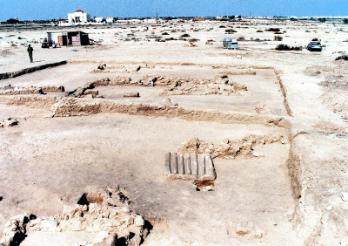Contact Center
.
A´Ali Early Islamic Settlement
The early Islamic settlement site of A'ali is situated about 650m to the west of the centre of the present-day village. The archaeological site appears as a low tell (mound) of about 160 x 85m, and does not exceed 1m in height. The site was partially excavated between 1988 and 1990 by a Japanese team.
Only the upper layer of the mound was studied at that time. It revealed the traces of a small Islamic settlement, mainly occupied between the latter half of the 8th century to the early half of the 9th century CE (Early Islamic Period/Early Abbasid period), according to most of the collected pottery, with a possible later extension during the 11th and 12th centuries. These constructions were the oldest traces of the Islamic presence in Bahrain at the time of their discovery. The site was interpreted as a local farmer's settlement, providing dates, cereals and cattle in the central region of Bahrain Island in the Abbasid period.
The few exposed houses were badly preserved, and only the base of the walls, made from small unshaped limestone blocks and clay mortar, were identified. Traces of white plaster were observed on some part of the walls and floors. The average size of the inner rooms was about 4/5m by 5/6m. Several ovens (tannur) and a relatively well preserved madbasa floor (installation for storing dates and producing date syrup) were also excavated in 1988.
The discovered artefacts consist of many fragments of ceramic and glass, a few complete pottery vessels, and some metal items. In addition to local earthenware products, the people at A'ali used a lot of blue-green glazed ware, opaque-white glazed ware, cobalt blue painted ware, green painted ware, and lustre painted ware, all imported from Mesopotamia (Iraq). A small number of Chinese pottery fragments were also found at the site










